Topolograph
This is a OSPF/IS-IS visualization and analytics tool for network engineers which is aimed at working with OSPF/IS-IS network offline.
v2.27 OSPF Watcher is integrated into Topolograph under Monitoring page!
v2.32 Create topology tab allows to create a topology from scratch or edit already uploaded OSPF/IS-IS topology earlier.
v2.38 IS-IS Watcher is integrated into Topolograph under Monitoring page!
v2.53.3 LLM Friendly! Topolograph now includes built-in MCP (Model Context Protocol) on top of API for seamless integration with Large Language Models and AI agents. Enable intelligent network analysis and automation!
v2.54 IS-IS BGP-LS Topolograph now supports IS-IS BGP-LS topology visualization and analysis!
All releases.
How to start working with your OSPF/IS-IS network graph offline?
Two steps:
- Find your device's vendor in the commands table and save the command's outputs from one of your routers as a single TXT file.
- Upload it to the Topolograph (here or in docker's version) via UI or API.
No logins and passwords are needed to provide!
Once you get your network graph you can:
Demo
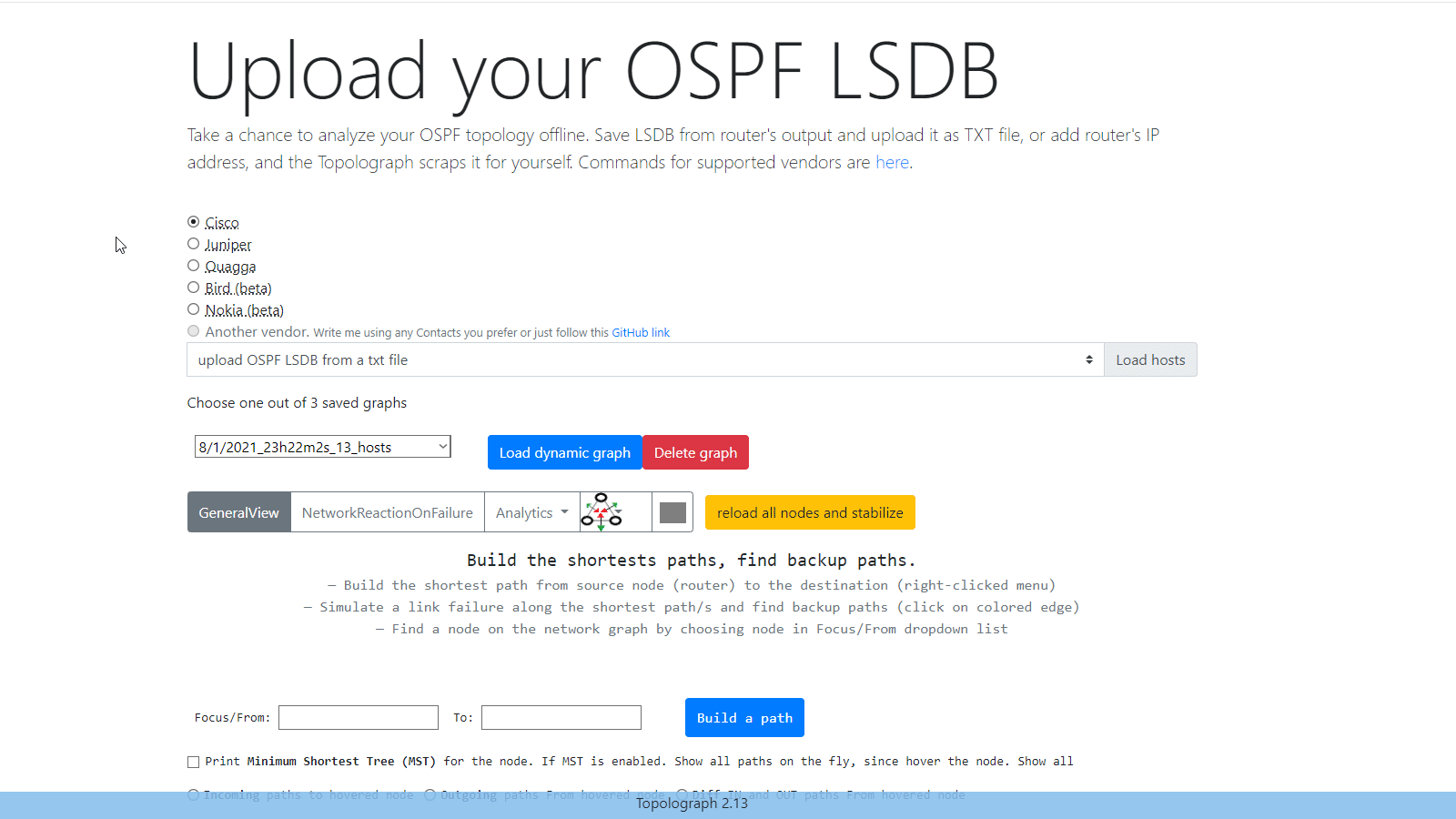
Features

Demo graph
Test topolograph's functionality right now! A test graph with 13 hosts has already pre-uploaded for everyone.
Demo OSPF network-graph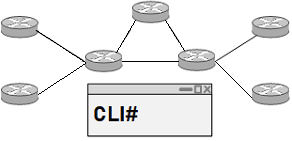
Visualization
1. Save OSPF LSDB as txt file or use Napalm (for dockered version)
2. Get your OSPF topology visual
Upload your topology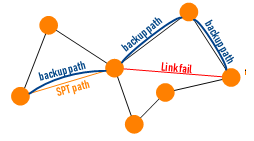
Offline Network Analysis
1. Simulate the link outage
2. Find network reaction on a failure
NetworkReactionOnFailure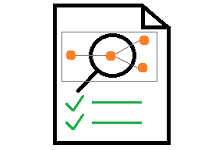
Reports
Reports can help to discover undirected links or asymmetric paths is your topology
Start Analysis
In order to get familiar with the principles of calculating backup paths in the event of a link or node falling, you can play with Demo OSPF Graph!
Once you build SPT and check Backup paths, see network reaction on link or network shutdown etc!
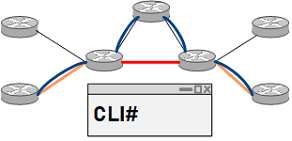
Get your OSPF topology visual on the Upload LSDB page
Save an output from your router (i.e. Cisco):- show ip ospf database router
- show ip ospf database network
- show ip ospf database external
If you have multiarea network - save outputs with different ABRs in the same file and then upload it on the Upload LSDB page. For not-registered users only one topology is saved. For registered users this limit is increased upto 5 topologies.

Check how the shortest path goes.
Traceroute or mtr is not helpful when a packet goes through a firewall. The firewall won't appear in a trace. In order to check the actual path through all network devices - build the shortest path using several ways:
- by dropdown menu
- by using right-clicked menu
In order to see a backup path - just press on a colored spt edge link. The algorithm will exclude this link and build a backup path.
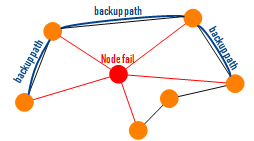
What will be if we shutdown our Core switch or... one of our border router?)
You can find the network reaction in NetworkReactionOnFailure tab. Just choose your node (network device) and simulate shutdown from right-clicked menu. The algorithm will exclude this node from the topology and show you consequences of your test.
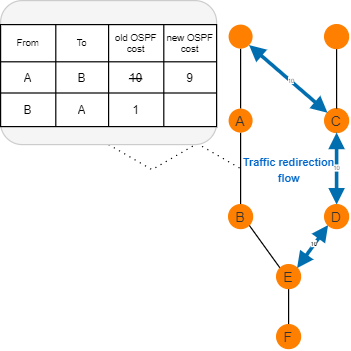
Change OSPF cost on a link on the fly.
Right-click on an edge and set a new OSPF cost. Topolograph shows the traffic change flow - links with a decreased and increased amount of traffic. If we set OSPF cost 9 between Node A and Node B - traffic will be redirected to a link via Node C and Node D. This feature is going to be used when you want to adjust OSPF cost and would like to see the output of your changes.
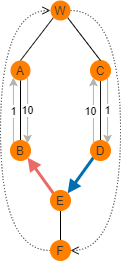
Report. Asymmetric paths in OSPF domains.
When different costs are configured on different links - asymmetric paths could be in the network. The incoming path from W to F is going via C-D, but the outgoing path is via B-A. Paths can go via different ISPs and come with different delays and, probably, losses. The report is aimed at discovering such cases in order to eliminate it.
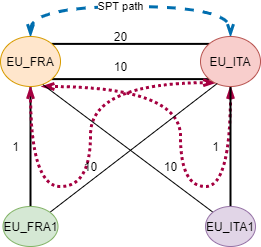
Report. Backup paths via 3d party locations.
This report checks that if two locations are directly connected, backup paths should be only between two locations and do not go via third location as transit. Before running this report - it's needed to create groups (~site names/locations) and assign devices to groups. For example, there are two locations in France: the main site (EU_FRA) and the remote site (EU_FRA1). The same schema with offices in Italy. The main offices in France and Italy are connected to each other and have main (OSPF cost 10) and backup (OSPF cost 20) link.Remote offices have the main link (OSPF cost 1) to their main offices and backup link (OSPF cost 10) to the foreign office.
If the main link between main offices goes down - the backup path goes via remote offices!
Report. Network heatmap.
The topolograph knows what networks are advertised by nodes. When the network is terminated on both routers, using VRRP, both nodes advertise the network. The node is marked by red if it has a lot of unbackuped networks, and vise versa.
Privacy. Keep your network inside your organization.
Run your local copy of Topolograph inside your on-premises network using the docker compose file topolograph-docker.
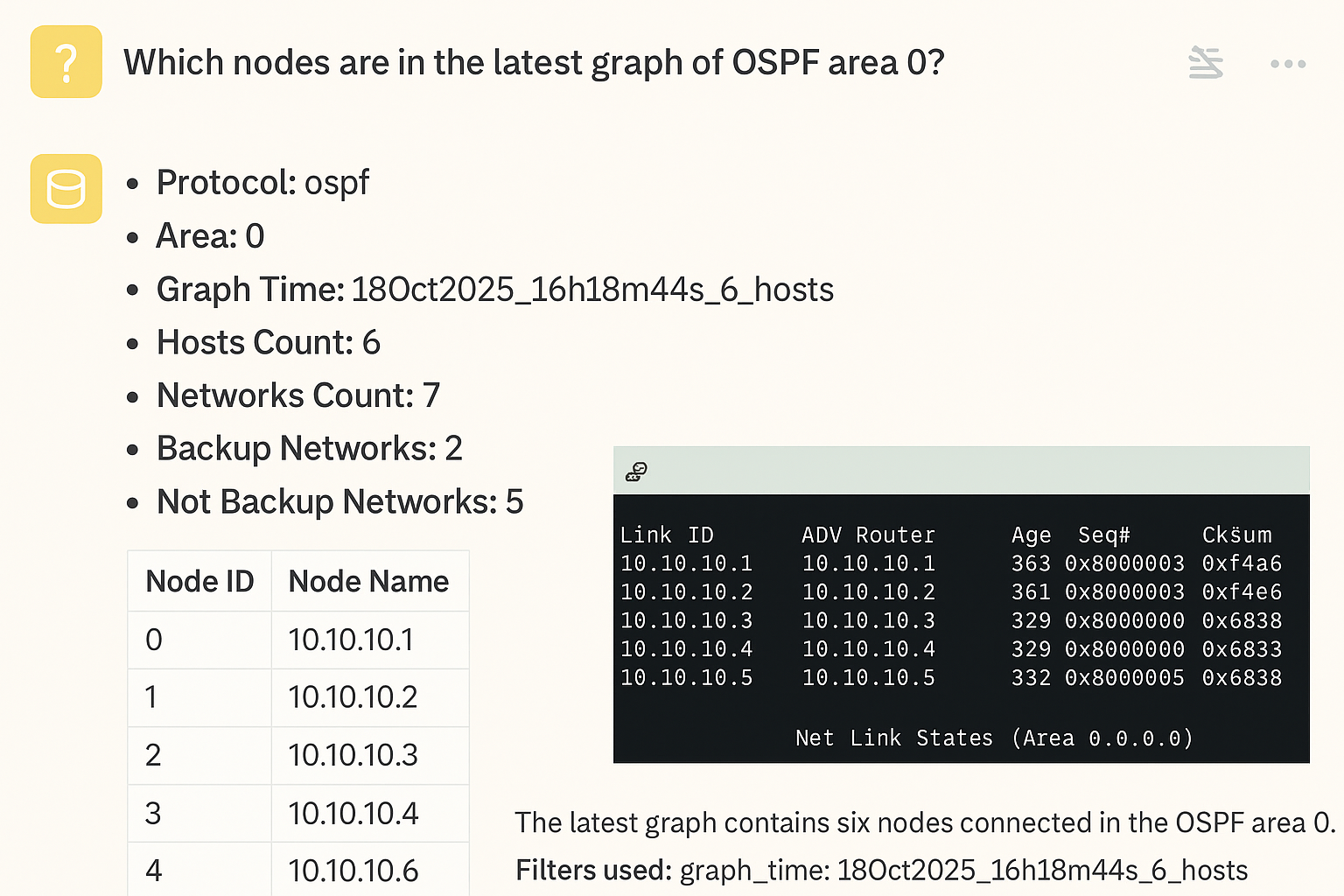
🤖 LLM Integration. AI-Powered Network Analysis.
Topolograph now supports Large Language Models (LLMs) through built-in MCP (Model Context Protocol) server. AI agents can directly query network topologies, analyze OSPF/IS-IS events, calculate paths, and perform intelligent network analysis. This enables automated network troubleshooting, predictive analysis, and intelligent network operations.
MCP server repository topolograph-mcp-server.
OSPF LSDB commands
Save the output from min two commands (for getting LSA1 and LSA2) into a file with .txt or .log extenstion and upload it to Topolograph.
| Vendor | LSA1 | LSA2 | LSA5 | NAPALM support |
|---|---|---|---|---|
| Cisco | show ip ospf database router | show ip ospf database network | show ip ospf database external | YES |
| Cisco NX-OS | show ip ospf database router detail | show ip ospf database network detail | show ip ospf database external detail | NO |
| Fortinet | get router info ospf database router lsa | get router info ospf database network lsa | get router info ospf database external lsa | NO |
| FRR/Quagga | show ip ospf database router | show ip ospf database network | show ip ospf database external | YES |
| Ruckus | show ip ospf database link-state router | show ip ospf database link-state network | show ip ospf database external-link-state | No |
| Juniper | show ospf database router extensive | no-more | show ospf database network extensive | no-more | show ospf database external extensive | no-more | YES |
| Bird | show ospf state all | show ospf state all | show ospf state all | NO |
| Nokia | show router ospf database type router detail | show router ospf database type network detail | show router ospf database type external detail | YES |
| Mikrotik | /routing ospf lsa print detail file=lsa.txt | /routing ospf lsa print detail file=lsa.txt | /routing ospf lsa print detail file=lsa.txt | No |
| Huawei | display ospf lsdb router | display ospf lsdb network | display ospf lsdb ase | No |
| Paloalto | show routing protocol ospf dumplsdb | show routing protocol ospf dumplsdb | show routing protocol ospf dumplsdb | No |
| show ip ospf link-state detail (Stub subnets without mask!) | show ip ospf link-state detail | show ip ospf external-link-state(LSA5 subnets without mask!) | No | |
| Ubiquiti | show ip ospf database router | show ip ospf database network | show ip ospf database external | No |
| Allied Telesis | show ip ospf database router | show ip ospf database network | show ip ospf database external | No |
| Extreme | show ospf lsdb detail lstype router | show ospf lsdb detail lstype network | show ospf lsdb detail lstype as-external | No |
| Ericsson | show ospf database router detail | show ospf database network detail | show ospf database external detail | No |
| Mandatory | YES | YES | NO |
OSPFv3 LSDB commands
OSPFv3 (RFC 5340) LSDB topology visualization. Save the output from the command into a file with .txt or .log extenstion and upload it to Topolograph.
| Vendor | Command | API support |
|---|---|---|
| Arista | show ipv6 ospf database detail | YES |
IS-IS LSDB commands
Save the output from the command into a file with .txt or .log extenstion and upload it to Topolograph.
| Vendor | Command | API support |
|---|---|---|
| Cisco | show isis database detail | YES |
| Juniper | show isis database extensive | YES |
| Nokia | show router isis database detail | YES |
| Huawei | display isis lsdb verbose | YES |
| FRR | show isis database detail* (router-isis#no hostname dynamic) | YES |
*FRR mixes LSPIDs and dynamic hostnames in IS-IS LSDB, that's why building IS-IS topology without hostnames is supported only. "no hostname dynamic" disable dynamic hostnames in local IS-IS LSDB.
IS-IS TLV support
| TLV name | TLV number | Cisco | Juniper | Nokia | FRR | Huawei | ZTE |
|---|---|---|---|---|---|---|---|
| IS Reachability | 2 | YES | YES | YES | YES | YES | |
| Extended IS Reachability (new) | 22 | YES | YES | YES | YES | YES | YES |
| IPv4 Internal Reachability (old) | 128 | YES | YES | YES | YES | YES | |
| IPv4 External Reachability (old) | 130 | ||||||
| Extended IPv4 Reachability (new) | 135 | YES | YES | YES | YES | YES | YES |
| IPv6 Reachability | 2 | YES | YES | YES | YES | YES | YES |
IS-IS BGP-LS support
IS-IS BGP-LS topology export settings are available on the Topolograph GitHub page.